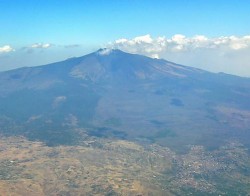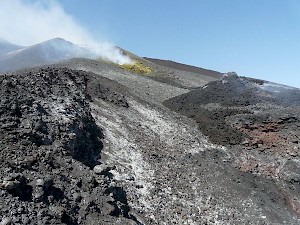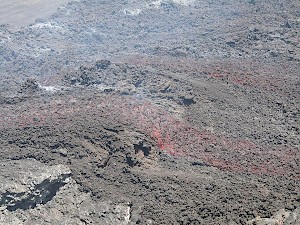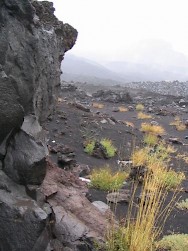Etna
Q16990Etna: volcano in Sicily.

Mount Etna, here seen from the southwest, is situated in the northeast of the Italian island Sicily. The isolated mountain, which today is about 3340 meters high, is visible from a great distance and dominates the Strait of Messina. It used to be covered with fir and pine forests, which had disappeared during the reign of the emperor Augustus.note
It is probably the most active volcano in Europe; it certainly is the volcano with the longest recorded history. The Athenian playwright Aeschylus and the poet Pindar mention the eruption of 476/475 and the historian Thucydides refers to a similar event in 425.

The eruption of 396 was recorded by Diodorus of Sicily.note The list of omens by Julius Obsequens (based on the Roman historian Livy) refers to other volcanic activities in 140, 135, and 126. Orosius mentions an eruption in 123 BCE, Petronius knows of activity in 49, Virgil in 44, Appian of Alexandria in 38, and Cassius Dio in 32 BCE. This list of ancient eruptions is concluded by Suetonius, who informs us that Mount Etna was active in 40 CE.note
Like the nearby Stromboli, Mount Etna is a stratovolcano, which means that it is a conical mountain that was built by the eruption of lava, ashes, and pyroclastic flows. As a consequence, it becomes very steep (sometimes >30º) as one approaches the summit; worse, the dark cinders and loose ash make it almost impossible to climb to the top, as the Roman emperor Hadrian experienced in 125. The main caldera is usually quiet; when the volcano is active, lava slowly and regularly flows from one of the two hundred smaller vents down the slopes, sometimes reaching the sea. However, real explosions have also been recorded.

When you visit the dark and inhospitable landscape, it is easy to imagine that in Antiquity, it was believed that the fire-breathing Enceladus was buried alive in Sicily; when he moved, earthquakes were the result. Alternatively, the fire-breather was a monster named Typhon. The god Hephaestion (or Vulcan) had his forge inside Mount Etna, and the Cyclopes were believed to have lived in caves. Because of its height, it was believed to be a place where people had gathered during the Great Flood, and survived.note
Another story about the Etna, set in the fourth century BCE, is that of the pious brethren Amphinomus and Anapias, who risked their lives when they carried their parents out of a burning house, but received divine protection when the stream of lava suddenly divided itself. The two boys were still venerated during in the first century CE, and their home town Catana showed their deed on its coins. The story is told by several authors; one charming version is by Claudian,note another by the anonymous author of the Latin poem Aetna.note

This, incorrectly attributed to Virgil and written before the eruption of the Vesuvius in 79, was written by someone who despised mythological explanations for volcanic eruptions and believed that the force causing eruptions is air operating in the caves and grottoes deep inside the mountain. A similar explanation was offered by Philostratus.note
Today, the volcano is one of Italy's most beautiful national parks (Parco Regionale dell' Etna). Among the trees are stone pines, birch, beech, and oak; in the lakes and streams you will see toads and frogs, ducks and herons; elsewhere, you can spot hedgehogs and porcupines, lizards, owls, hare, weasels, squirrels, weasels, and foxes; in the Middle ages, the rabbits were brought from Spain and the partridges from the Near East. Finally, the only animals that can fully appreciate the beautiful desolation of the cold and windy summit are the falcons and eagles.